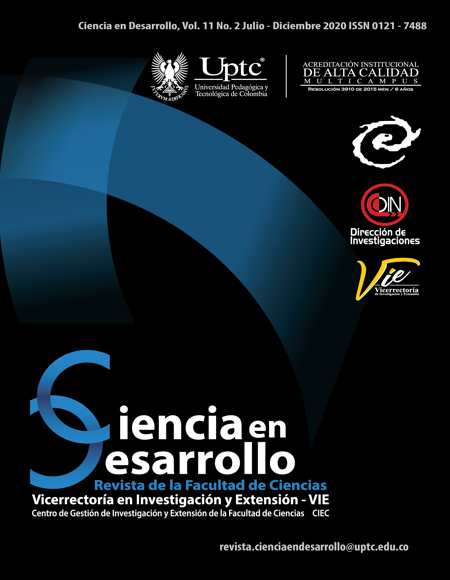Spectrophotometric Determination Profile Of Bisphenol A In The Photodegradation Process With Singlet Molecular Oxygen

Abstract
In this study, a strategy using Partial Least Squares (PLS) as a chemometric tool to establish the robustness of the photosensitized degradation process of Bisphenol A in simulated effluents was assessed. In the first stage of the research, the validation of the methodology that allows the quantification of Bisphenol A (BPA) mixed with the photosensitizer Eosin Y (EOS) in aqueous solution was carried out. Through the use of spectrophotometry as monitoring technique, it was possible to establish the optimal number of factors and the wavelength range, and to determine that was possible to ensure the quantification of BPA by means of PLS, by demonstrating complex formation between BPA and EOS. The RMSE results were 0.004237 at 284 nm and 0.009167 at 524 nm, demonstrating good robustness in the analysis. Next, preliminary tests were carried out on the effect of direct light using a mercury lamp as a source of irradiation. In the case of BPA, it was determined that 100% degradation is achieved at 100 minutes.
Keywords
Chemometric, PLS, robustness, quantification, spectrophotometry, photosensitizer, photosensitization
References
[1] C. a Staples, P. B. Dom, G. M. Klecka, T. O. Sandra, and L. R. Harris, “A review of the environmental fate, effects, and exposures of Bisphenol A,” Chemosphere, vol. 36, no. 10, pp. 2149–2173, 1998, doi: 10.1016/S0045-6535(97)10133-3.
[2] N. Bolong, a. F. Ismail, M. R. Salim, and T. Matsuura, “A review of the effects of emerging contaminants in wastewater and options for their removal,” Desalination, vol. 238, no. 1–3, pp. 229–246, 2009, doi: 10.1016/j.desal.2008.03.020.
[3] J. Gil, M. Soto, J. Usma, and O. Gutiérrez, “Contaminantes emergentes en aguas, efectos y posibles tratamientos,” Prod. Más Limpia, vol. 7, no. 2, pp. 52–73, 2012.
[4] L. N. Vandenberg, R. Hauser, M. Marcus, N. Olea, and W. V. Welshons, “Human exposure to bisphenol A (BPA),” Reproductive Toxicology, vol. 24, no. 2. pp. 139–177, 2007, doi: 10.1016/j.reprotox.2007.07.010.
[5] FDA, “‘Final report for the review of literature and data on BPA,’” 2014.
[6] EPA, “Bisphenol A (BPA) Action Plan,” 2010. [Online]. Available: https://www.epa.gov/assessing-and-managing-chemicals-under-tsca/bisphenol-bpa-action-plan.
[7] EPA, “Use of High Throughput Assays and Computational Tools in the Endocrine Disruptor Screening Program,” 2015. [Online]. Available: https://www.epa.gov/endocrine-disruption/use-high-throughput-assays-and-computational-tools-endocrine-disruptor#screening.
[8] EFSA, “Bisphenol A: new immune system evidence useful but limited,” 2016. [Online]. Available: http://www.efsa.europa.eu/en/press/news/161013.
[9] R. Andreozzi, “Advanced oxidation processes (AOP) for water purification and recovery,” Catal. Today, vol. 53, no. 1, pp. 51–59, 1999, doi: 10.1016/S0920-5861(99)00102-9.
[10] P. R. Gogate and A. B. Pandit, “A review of imperative technologies for wastewater treatment I: Oxidation technologies at ambient conditions,” Adv. Environ. Res., vol. 8, no. 3–4, pp. 501–551, 2004, doi: 10.1016/S1093-0191(03)00032-7.
[11] N. De la Cruz et al., “Degradation of emergent contaminants by UV, UV/H2O2 and neutral photo-Fenton at pilot scale in a domestic wastewater treatment plant,” Water Res., vol. 47, no. 15, pp. 5836–5845, 2013, doi: 10.1016/j.watres.2013.07.005.
[12] M. C. DeRosa and R. J. Crutchley, “Photosensitized singlet oxygen and its applications.pdf,” Coord. Chem. Rev., vol. 234, pp. 351–371, 2002.
[13] R. Bonnett, “Photosensitizers of the porphyrin and phthalocyanine series for photodynamic therapy,” Chem. Soc. Rev., vol. 24, no. 1, p. 19, 1995, doi: 10.1039/cs9952400019.
[14] F. Amat-Guerri, M. M. C. López-González, R. Martínez-Utrilla, and R. Sastre, “Singlet oxygen photogeneration by ionized and un-ionized derivatives of Rose Bengal and Eosin Y in diluted solutions,” J. Photochem. Photobiol. A Chem., vol. 53, no. 2, pp. 199–210, 1990, doi: 10.1016/1010-6030(90)87124-T.
[15] C. Bosch Ojeda and F. Sanchez Rojas, “Recent applications in derivative ultraviolet/visible absorption spectrophotometry: 2009-2011. A review,” Microchem. J., vol. 106, pp. 1–16, 2013, doi: 10.1016/j.microc.2012.05.012.
[16] D. Prato-Garcia and G. Buitrón, “Improvement of the robustness of solar photo-Fenton processes using chemometric techniques for the decolorization of azo dye mixtures,” J. Environ. Manage., vol. 131, pp. 66–73, 2013, doi: 10.1016/j.jenvman.2013.09.018.
[17] D. G. Kleinbaum, L. L. Kupper, K. E. Muller, and P. D. Press, Applied Regression Analysis and Other Multivariable Methods. 1978.
[18] N. Kumar, A. Bansal, G. S. Sarma, and R. K. Rawal, “Chemometrics tools used in analytical chemistry: An overview,” Talanta, vol. 123, pp. 186–199, 2014, doi: 10.1016/j.talanta.2014.02.003.
[19] H. Díaz, A. León, and G. Fraga, “Determinación esoectrofotometrica simultanea de la carbamazepina y fenobarbital en mezclas sinteticas utilizando la regresión por minimos cuadrados parciales,” Rev. Cuba. Química, vol. XX, no. 1, pp. 9–18, 2008.
[20] R. G. Brereton, “Introduction to multivariate calibration in analytical chemistry,” Analyst, vol. 125, no. 11, pp. 2125–2154, 2000, doi: 10.1039/b003805i.
[21] M. Grootveld, “Introduction to the Applications of Chemometric Techniques in ‘ Omics ’ Research : Common Pitfalls , Misconceptions and ‘ Rights and Wrongs ,’” in Metabolic profiling:disease and xenobiotics, no. 21, 2015, pp. 1–34.
[22] J. C. Vega- Vilca and Gúzman Jose, “Regresion PLS y PCA como solución al problema de multicolinealidad en regresión múltiple,” Rev. matemática Teor. y Apl., vol. 18, no. 1, pp. 9–20, 2011.
[23] A. Hoskuldsson, “A combined theory for PCA AND PLS,” J. Chemom., vol. 9, pp. 91–123, 1995.
[24] E. Díez-Mato, F. C. Cortezón-Tamarit, S. Bogialli, D. García-Fresnadillo, and M. D. Marazuela, “Phototransformation of model micropollutants in water samples by photocatalytic singlet oxygen production in heterogeneous medium,” Appl. Catal. B Environ., vol. 160–161, pp. 445–455, 2014.
[25] H. Benesi and J. H. Hildebrand, “A Spectrophotometric Investigation of the Interaction of Iodine with Aromatic Hydrocarbons,” vol. 2832, no. 1948, 1949.
[26] PEN-RAY, “Penray lamps spectra,” Pen-ray lamps spectra, 2017.
